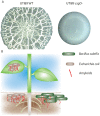Disease to dirt: the biology of microbial amyloids
- PMID: 24278013
- PMCID: PMC3836715
- DOI: 10.1371/journal.ppat.1003740
Disease to dirt: the biology of microbial amyloids
Conflict of interest statement
The authors have declared that no competing interests exist.
Figures


Similar articles
-
Beyond the expected: the structural and functional diversity of bacterial amyloids.Crit Rev Microbiol. 2018 Nov;44(6):653-666. doi: 10.1080/1040841X.2018.1491527. Epub 2018 Oct 25. Crit Rev Microbiol. 2018. PMID: 30354913 Review.
-
Two Decades of Studying Functional Amyloids in Microorganisms.Trends Microbiol. 2021 Mar;29(3):251-265. doi: 10.1016/j.tim.2020.09.005. Epub 2020 Oct 9. Trends Microbiol. 2021. PMID: 33041179 Review.
-
The Role of Functional Amyloids in Bacterial Virulence.J Mol Biol. 2018 Oct 12;430(20):3657-3684. doi: 10.1016/j.jmb.2018.07.010. Epub 2018 Jul 12. J Mol Biol. 2018. PMID: 30009771 Free PMC article. Review.
-
Microbial amyloids--functions and interactions within the host.Curr Opin Microbiol. 2013 Feb;16(1):93-9. doi: 10.1016/j.mib.2012.12.001. Epub 2013 Jan 9. Curr Opin Microbiol. 2013. PMID: 23313395 Free PMC article. Review.
-
Bacterial functional amyloids: Order from disorder.Biochim Biophys Acta Proteins Proteom. 2019 Oct;1867(10):954-960. doi: 10.1016/j.bbapap.2019.05.010. Epub 2019 Jun 10. Biochim Biophys Acta Proteins Proteom. 2019. PMID: 31195143 Free PMC article. Review.
Cited by
-
Perioperative neurocognitive dysfunction: thinking from the gut?Aging (Albany NY). 2020 Aug 15;12(15):15797-15817. doi: 10.18632/aging.103738. Epub 2020 Aug 15. Aging (Albany NY). 2020. PMID: 32805716 Free PMC article.
-
Amyloid-containing biofilms and autoimmunity.Curr Opin Struct Biol. 2022 Aug;75:102435. doi: 10.1016/j.sbi.2022.102435. Epub 2022 Jul 18. Curr Opin Struct Biol. 2022. PMID: 35863164 Free PMC article. Review.
-
Antibiotic Consumption Patterns in European Countries Are Associated with the Prevalence of Parkinson's Disease; the Possible Augmenting Role of the Narrow-Spectrum Penicillin.Antibiotics (Basel). 2022 Aug 23;11(9):1145. doi: 10.3390/antibiotics11091145. Antibiotics (Basel). 2022. PMID: 36139924 Free PMC article.
-
Electrostatic interactions mediate the nucleation and growth of a bacterial functional amyloid.Front Mol Biosci. 2023 Jan 12;10:1070521. doi: 10.3389/fmolb.2023.1070521. eCollection 2023. Front Mol Biosci. 2023. PMID: 36756360 Free PMC article.
-
Gut Microbiota, Probiotic Interventions, and Cognitive Function in the Elderly: A Review of Current Knowledge.Nutrients. 2021 Jul 23;13(8):2514. doi: 10.3390/nu13082514. Nutrients. 2021. PMID: 34444674 Free PMC article. Review.
References
-
- Fowler DM, Koulov AV, Balch WE, Kelly JW (2007) Functional amyloid–from bacteria to humans. Trends Biochem Sci 32: 217–224. - PubMed
-
- Schwartz K, Syed AK, Stephenson RE, Rickard AH, Boles BR (2012) Functional amyloids composed of phenol soluble modulins stabilize Staphylococcus aureus biofilms. PLoS Pathog 8: e1002744 doi:10.1371/journal.ppat.1002744 - DOI - PMC - PubMed
Publication types
MeSH terms
Substances
Grants and funding
LinkOut - more resources
Full Text Sources
Other Literature Sources

